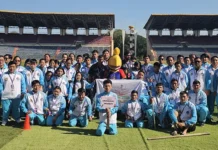RONO HILLS, Sep 14: Prof Amitava Mitra, Vice-Chancellor In-charge of Rajiv Gandhi University (RGU), released a book titled Discovering Eastern Himalaya: The Arunachal Pradesh: West Kameng and Tawang, authored by Prof Hirendra Nath Sarma of the university’s zoology department.
The book is published under the UGC-sponsored Centre with Potential for Excellence in Biodiversity (CPEB) project being executed in the RGU.
“It will be a guide book for explorers, travellers and researchers, and an asset for RGU as well as the people of Arunachal Pradesh and India,” Prof Mitra said after releasing the book.
“There is need of such books to document nature, natural resources, and human culture of Arunachal Pradesh,” he said, and praised the work as “an extraordinary performance and achievement” under Phase-II of the CPEB project.
Former vice-chancellor Prof Tamo Mibang said Arunachal Pradesh has rich bio-resources as well as human culture which need proper documentation in book form.
He termed the book “an excellent piece of document on the western part of Arunachal Pradesh.”
RGU Registrar In-charge Prof Tomo Riba termed the book “a rare piece wherein the author has covered almost all the aspects of life in that region, from the tiniest of insects to rare orchids, tourism to economy, and the services and sacrifices of the Indian Army for the nation.”
The author of the book, Prof Sarma, said it took him five years to gather the data and compile them into a book.
He said the purpose of writing the book was to document the diverse landscapes, biodiversity and the culture of the people of West Kameng and Tawang districts, “as the area is undergoing rapid transition and development which may bring changes and even loss of these elements in the future.”
He expressed gratitude to the University Grants Commission for financial assistance, and to the people of West Kameng and Tawang for generously providing information for the book.
Botany Department Head Dr Hui Tag said the rich bio-resources of Arunachal Pradesh (which is part of the eastern Himalayan biodiversity hotspot) are under tremendous threat from people.
“Therefore documentation is imperative, and the book is a magnificent effort towards this direction,” he said.
Zoology Assistant Professor Dr Daniel Mize also spoke.


